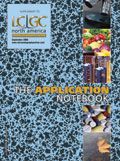Reversed-Phase HPLC Column at Extreme High Temperature (150°C or Higher)
The Application Notebook
In general, polymer-based columns have a broad pH range (pH 2 to 13), and some have high temperature tolerance (up to 150°C or higher). Considerably large selectivity changes can be obtained by varying analysis temperature and mobile phase pH. Having control on these two parameters over wide ranges can be especially useful in method development.
Ken Tseng1 , Gerd Vanhoenacker2 , Takashi Kotsuka3 , and Pat Sandra2 ,1 Shodex, Showa Denko American, Inc., 2 Research Institute for Chromatography, and 3 Showa Denko K.K.
In general, polymer-based columns have a broad pH range (pH 2 to 13), and some have high temperature tolerance (up to 150°C or higher). Considerably large selectivity changes can be obtained by varying analysis temperature and mobile phase pH. Having control on these two parameters over wide ranges can be especially useful in method development.

Figure 1
At high temperature,
- Decreased mobile phase viscosity enhances diffusion rate between the mobile phase and the polymer-based stationary phase
- Shodex polymer-based ET-RP1 column - minimal plate height (hmin) decreased significantly
- Silica-based columns - the hmin is more or less constant
- Consequently, efficiency of the polymer-based column at high temperature and high flow rate is similar to the efficiency obtained with traditional columns
A new polymer-based reversed-phase HPLC column, Shodex ET-RP1, was developed jointly between Research Institute for Chromatography (RIC) and Shodex. It provides,
- 5 times faster analysis time
- Better efficiency
- Improved control in selectivity
- Less organic solvent consumption
- Decreased risk in sample degradation
- Long column life

Figure 2
Experimental Conditions
System: Agilent 1100
Column oven: SandraSelerity Technologies, Polaratherm
9000 Series
Mobile phase: A = ammonium acetate pH 8 in water
B = acetonitrile
Temperature: 40 to 150°C
Flow rate: 0.5 to 2.4 mL/min

Figure 3
Results and Conclusions
High temperature is especially beneficial for polymer-based column performance. This is mainly due to the decreased mobile phase viscosity, thus, enhanced diffusion rate between mobile phase and polymer-based stationary phase. The relatively low efficiency of polymer-based columns that generally is a major drawback can be overcome by applying high temperature, resulting in sharp peaks. The decreased solvent viscosity means flow rate can be increased significantly while maintaining a conventional HPLC pressure. Less organic solvents are needed at high temperature means less impact on the environment (and your budget). The results are even better if the flow rate is increased to greatly shorten analysis time, up to five times faster.

Figure 4
Furthermore, polymer-based columns have the advantage over silica-based in that they can be applied in a much wider pH range (pH 2 to 13) and at higher temperatures (up to 150 °C or higher). This expands the application range for these types of stationary phases. pH and temperature can be used more extensively in method development. The potential catalytic activity originating from the stationary phase material is substantially smaller in polymer-based columns compared to silica- and zirconium-based columns. Consequently the risk for sample degradation at high temperature conditions is reduced. In these experiments, the Shodex ET-RP1 column has shown good durability.

Table I

Shodex, Showa Denko America, Inc.
489 Fifth Avenue, 18th Floor, New York, NY 10017
tel. (212) 370-0033
fax (212) 370-4566
Email: support@shodex.net
General: www.shodex.com
America: www.shodex.net

Free Poster: NDSRI Risk Assessment and Trace-Level Analysis of N-Nitrosamines
April 25th 2025With increasing concern over genotoxic nitrosamine contaminants, regulatory bodies like the FDA and EMA have introduced strict guidelines following several high-profile drug recalls. This poster showcases a case study where LGC and Waters developed a UPLC/MS/MS method for quantifying trace levels of N-nitroso-sertraline in sertraline using Waters mass spectrometry and LGC reference standards.
New TRC Facility Accelerates Innovation and Delivery
April 25th 2025We’ve expanded our capabilities with a state-of-the-art, 200,000 sq ft TRC facility in Toronto, completed in 2024 and staffed by over 100 PhD- and MSc-level scientists. This investment enables the development of more innovative compounds, a broader catalogue and custom offering, and streamlined operations for faster delivery. • Our extensive range of over 100,000 high-quality research chemicals—including APIs, metabolites, and impurities in both native and stable isotope-labelled forms—provides essential tools for uncovering molecular disease mechanisms and exploring new opportunities for therapeutic intervention.
New Guide: Characterising Impurity Standards – What Defines “Good Enough?”
April 25th 2025Impurity reference standards (IRSs) are essential for accurately identifying and quantifying impurities in pharmaceutical development and manufacturing. Yet, with limited regulatory guidance on how much characterisation is truly required for different applications, selecting the right standard can be challenging. To help, LGC has developed a new interactive multimedia guide, packed with expert insights to support your decision-making and give you greater confidence when choosing the right IRS for your specific needs.
Using the Carcinogenic Potency Categorisation Approach (CPCA) to Classify N-nitrosamine Impurities
April 25th 2025Learn how to manage nitrosamine impurities in pharmaceuticals with our free infographic. Discover how the CPCA approach establishes acceptable intake limits and guides the selection of NDSRI reference samples. Stay compliant and ensure safety with our ISO-accredited standards.

.png&w=3840&q=75)

.png&w=3840&q=75)



.png&w=3840&q=75)



.png&w=3840&q=75)














